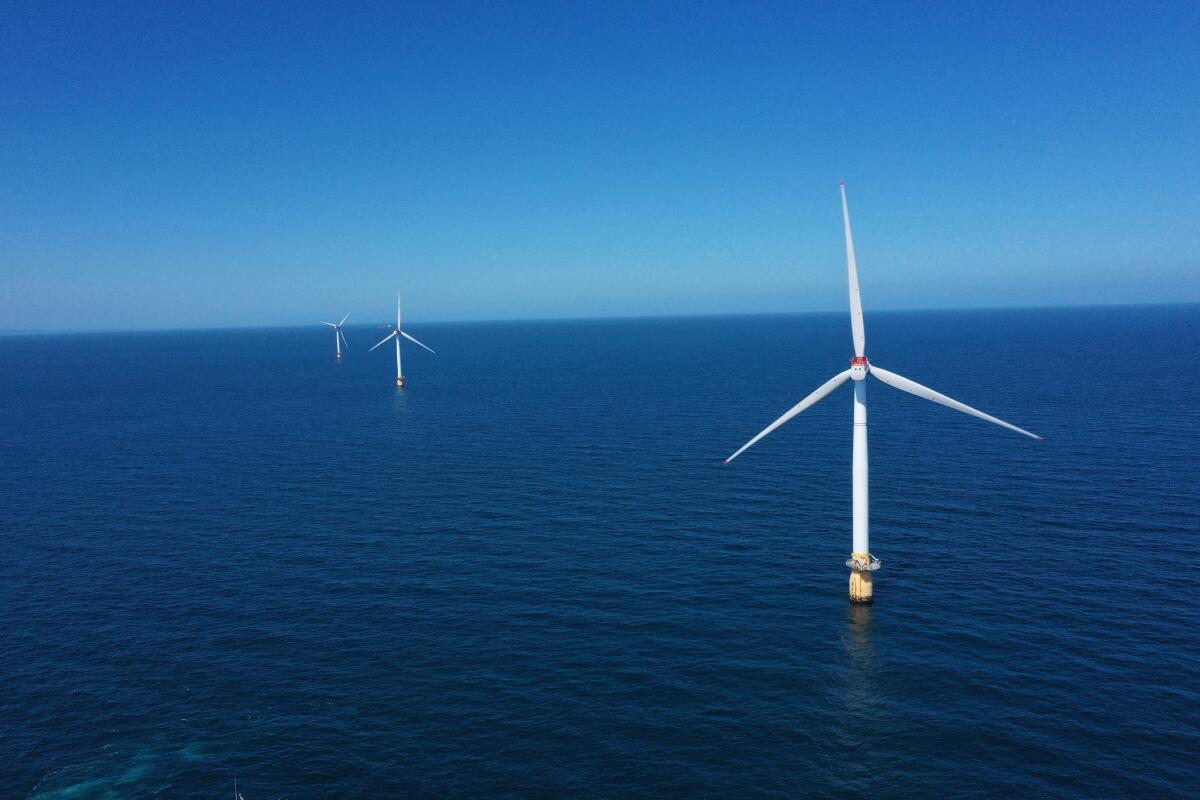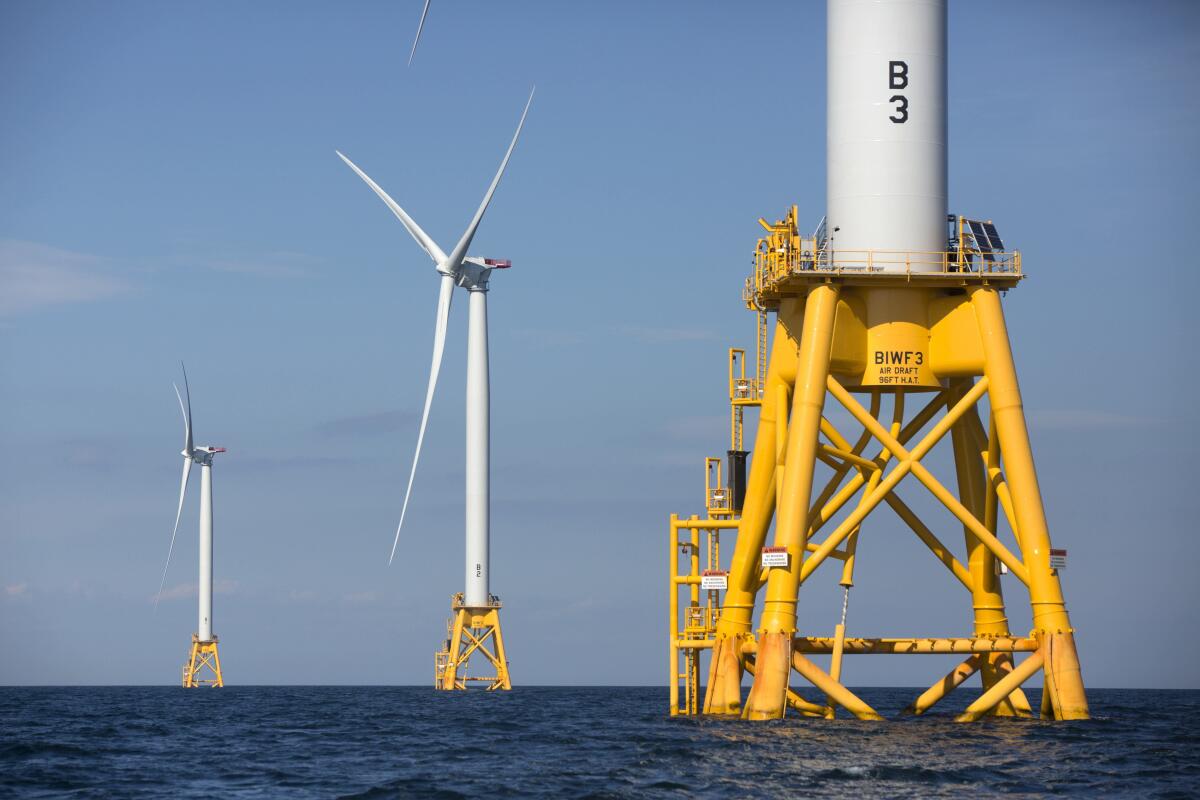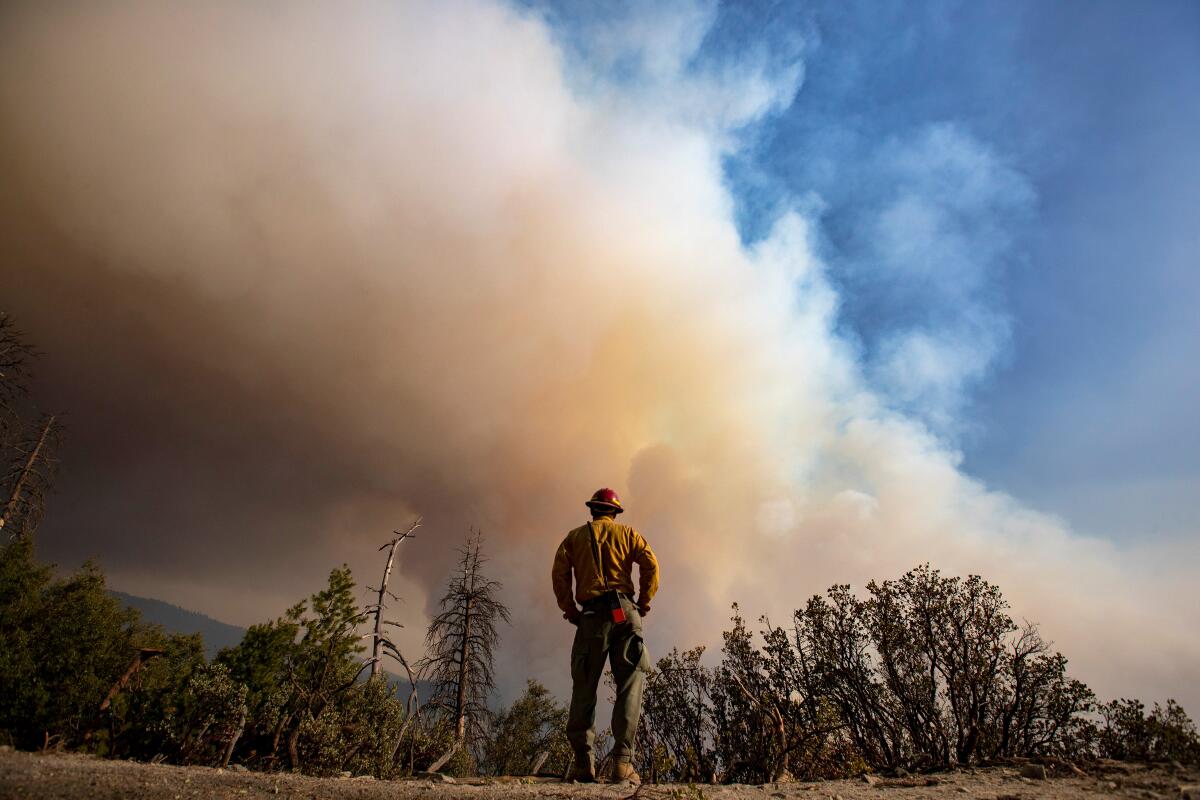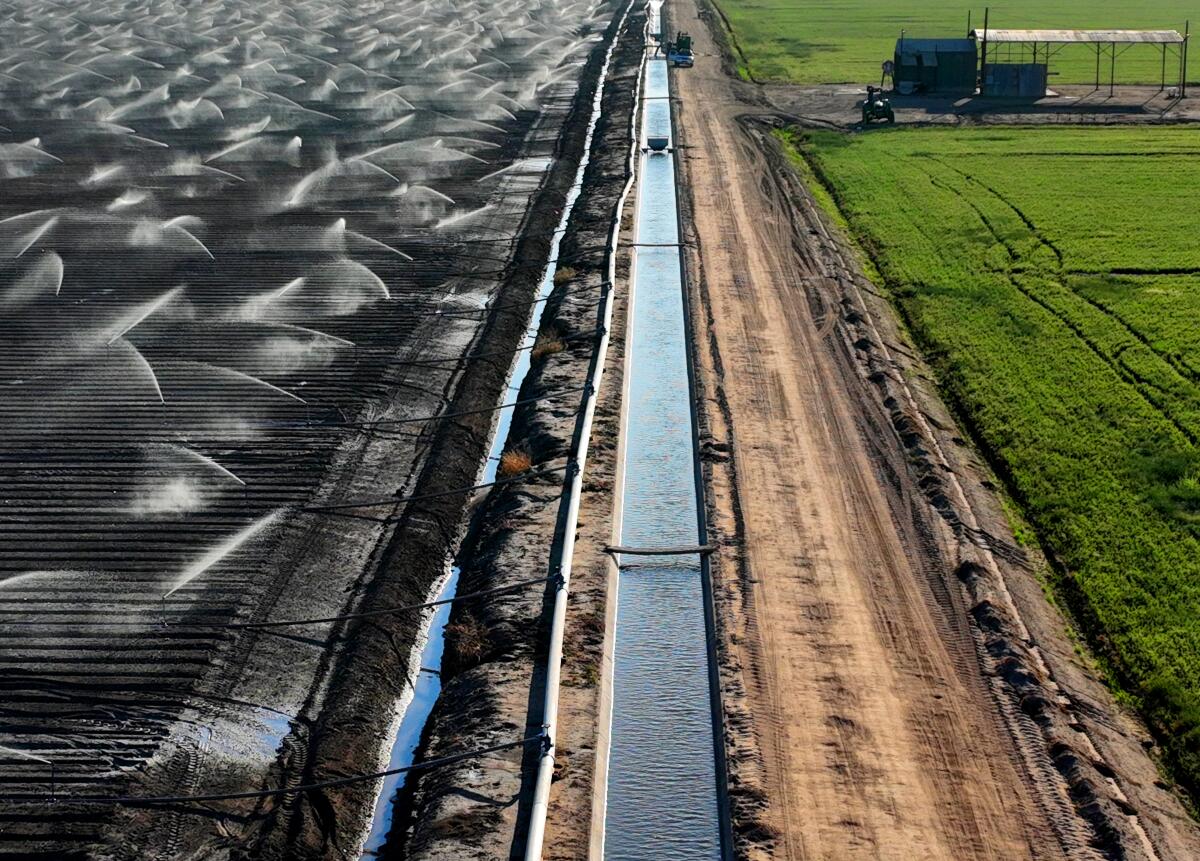California is going big on offshore wind. That’s good for climate, but not enough

- Share via
This story was originally published in Boiling Point, a newsletter about climate change and the environment. Sign up here to get it in your inbox.
It’s been a good week for offshore wind power.
Heading into Labor Day Weekend, California Gov. Gavin Newsom announced a deal with legislative leaders that could prompt construction of California’s first offshore wind farms — an expensive but valuable resource that researchers have found can play a key role in reaching 100% clean energy. The deal could also lead to development of new geothermal power plants in the Imperial Valley, and a “pumped storage” hydropower project in San Diego County — more useful tools for ditching fossil fuels.
The bill was approved by the state Senate’s energy committee in a 14-3 vote on Wednesday evening. It still needs approval from two-thirds of lawmakers in the Senate and Assembly by end of session Sept. 14 before it heads to Newsom’s desk.
“We’ve set some of the most ambitious clean energy goals in the nation to break the vicious cycle of climate change-caused energy emergencies — we need every tool at our disposal to achieve them,” Newsom said in a written statement.
The challenge for offshore wind developers is that it doesn’t make economic sense to build just a handful of costly floating wind turbines — big projects are the only logical investment. And there haven’t been any utility companies or local governments able to step forward and sign a large enough contract to give developers the financial certainty they need to start construction.
The deal struck by Newsom, Assembly Speaker Robert Rivas (D-Salinas) and Senate leader Toni Atkins (D-San Diego) would allow the state’s Department of Water Resources to sign long-term electricity contracts on behalf of all Californians.
Specifically, the department would purchase “diverse clean energy resources” that take a long time to develop and aren’t already being bought in sufficient amounts — if the Public Utilities Commission first determines those resources are necessary.
Basically, state lawmakers want to see renewable energy projects beyond just solar farms, onshore wind turbines and batteries. Those resources have the lowest costs, and they’re expected to do the bulk of the work getting California — and the rest of the country, one hopes — to 100% climate-friendly power. But they’re not enough. Between ever-hotter heat waves and occasional lengthy periods with low sunlight and wind, we’ll need other stuff to fill out the final 10% or 20%.

Floating wind turbines in the Pacific could be especially valuable because California’s ocean breezes blow more consistently than onshore winds. They also stay strong into the evening, after sundown, making them a good complement to solar power.
Then there’s pumped hydropower, which can store larger amounts of energy than typical lithium-ion batteries. The San Vicente project in San Diego County, which could get a contract through the deal in Sacramento, would pump water uphill from a lower reservoir when there’s extra power on the grid, then release water to flow through generators when more power is needed.
Geothermal power plants, meanwhile, can tap into Earth’s subterranean heat and generate climate-friendly energy 24/7 — and some of them can produce lithium for electric-vehicle batteries, too. Just last month, the parent company of Chrysler, Jeep and other leading car brands announced it would invest $100 million in a lithium and geothermal energy project being developed by Controlled Thermal Resources along the shores of California’s Salton Sea. (See my previous reporting on that project here.)
But back to the deal between Newsom and lawmakers.
For some perspective, I spoke with Alex Jackson, California director for the American Clean Power Assn., an industry trade group. He described the legislation — along with a recently approved bill to speed up infrastructure permitting, and last summer’s deal to make it easier for state officials to approve solar and wind farms over local objections — as a “down payment.”
For the Golden State to move beyond fossil fuels — and eliminate its reliance on polluting facilities such as coastal gas plants and the Aliso Canyon gas storage field — building renewable energy needs to be much simpler and faster, Jackson said.
“Infrastructure projects, which were once the source of pollution and inequity, are now absolutely foundational to getting us out of an existential crisis,” he said. “We have to let this be the start of much more significant reforms.”
New data published this week serve as a reminder of why that’s so important.
European Union scientists reported Wednesday that the last three months were the hottest summer on record globally, by a lot — and the hottest individual June, July and August too. Also Wednesday, the U.S. National Oceanic and Atmospheric Administration reported record-high greenhouse gases in the atmosphere, record-hot ocean waters and record-high sea levels in 2022.
California alone can’t solve this problem. So it matters to us that the Biden administration approved its fourth offshore wind farm along the East Coast last month. It also matters that there wasn’t much response to the administration’s first offshore wind auction in the Gulf of Mexico last week, in part because the Gulf states haven’t committed to buying any wind power.
But much of the world looks to California on confronting the climate crisis. What happens here doesn’t stay here.
Which brings us to another valuable source of clean energy.

Although state officials are moving to support big renewable power projects, they haven’t done much recently for smaller-scale local infrastructure. After voting last year to slash rooftop solar incentives for single-family homes, Newsom’s appointees on the Public Utilities Commission may soon do the same for multifamily homes, Canary Media’s Jeff St. John reports.
There’s widespread support, meanwhile, for a statewide proposal to jump-start community solar — local solar installations on empty lots, warehouses and other areas near homes. But monopoly utility companies Southern California Edison, Pacific Gas & Electric and San Diego Gas & Electric are trying to persuade the utilities commission to reject that proposal, St. John writes.
Will state lawmakers step in to defend rooftop solar? And what else might they do to accelerate our climate progress?
That could depend in large part on Rivas, who became Assembly speaker this summer, and Sen. Mike McGuire (D-Healdsburg), who will take over as Senate leader next year. Although it’s not yet clear what their top priorities will be, McGuire is known as a leader on climate and environmental policy who has repeatedly slammed PG&E for not doing more to prevent wildfire ignitions, my colleague Taryn Luna reports. And Rivas recently introduced a bill that would expedite badly needed upgrades to the Pajaro River levee, helping protect a town of mostly migrant farmworkers from future floods, The Times’ Susanne Rust reports.
In theory, the Golden State has lots of time to phase out fossil fuels — especially considering the progress we’ve already made. New data — broken down here by the San Diego Union-Tribune’s Rob Nikolewski — show that 54% of our electricity came from climate-friendly sources including solar, wind and geothermal in 2022. And that number doesn’t include rooftop solar.
But the state’s 2045 deadline for 100% clean energy looks increasingly antiquated. President Biden campaigned on cleaning up the power grid by 2035, in line with what many scientists say is necessary to avoid the worst harms of the climate crisis.
And even the 2045 target could be difficult because of the slow pace of building new power lines, which are crucial for moving clean energy from where it’s generated to the cities where it’s needed. In California and across the country, securing permission from landowners and government agencies along proposed transmission-line routes can take a decade or more.
Just last week, for instance, Pattern Energy broke ground on its $10-billion SunZia transmission line. As I wrote last month, SunZia will run 550 miles through New Mexico and Arizona and help carry wind power to customers including the University of California system — a big win for clean energy, but only after the project spent a mind-boggling 17 years going through permitting.
The deal struck by Newsom and top lawmakers could help move power lines forward, by making it harder for critics to challenge those lines at the Public Utilities Commission after another agency has determined they’re needed.
“We see that as a small step forward,” Jackson said. “It’s going to need to be paired with a whole lot more reforms.”

New electric lines are no panacea. In a reminder of the benefits of rooftop solar, the federal government is suing SoCal Edison over Los Angeles County’s destructive 2020 Bobcat fire, which investigators say was ignited by Edison power lines.
So although studies have found we’ll need a much bigger power grid to support renewable energy, anything we can do to limit the need for expensive, time-consuming new transmission lines is helpful. That’s one reason the California Independent System Operator — which oversees the grid for most of the state — is seeking federal approval of its plan to share more electricity with other Western states through existing wires. It’s a controversial but intriguing idea that I’ve written about previously.
Ensuring we’ve got a big enough, efficient enough power grid should also help Californians stop burning so much oil and gas in our daily lives. Switching to electric vehicles is key, as is replacing gas heaters and stoves with electric appliances.
As I’ve reported previously, the push for electric heat pumps and induction stoves has put pressure on Southern California Gas Co., the nation’s largest gas utility. The Sacramento Bee’s Joe Rubin and Ari Plachta examined that pressure last month with a strong investigation into the company’s attempted use of ratepayer dollars to fight clean energy policies — including previously unknown payments to the Business Federation of Los Angeles, which recruited antielectrification speakers for public meetings.
Plachta and Rubin also wrote about efforts by SoCalGas and the California Restaurant Assn. to encourage opposition to induction cooking. Sacramento, meanwhile, has become the latest city to pause enforcement of its ban on gas hookups in new homes and businesses after a court — responding to a California Restaurant Assn. lawsuit — threw out Berkeley’s first-in-the-nation gas ban.
Whatever happens with electrification and the power grid, there may be no more significant climate decision point facing California than the future of the Diablo Canyon nuclear plant, the state’s largest power source. In a big win for the facility’s supporters — including Newsom, who says extending Diablo Canyon’s 2025 shutdown deadline is crucial for climate progress — a judge has rejected the first of two lawsuits from Friends of the Earth seeking to close the nuclear plant on schedule.
Does that guarantee Diablo Canyon will stay open? No, not yet. But it’s looking increasingly likely.
I’ll keep tracking all of these issues week in, week out. For now, here’s what else is happening around the West:
CLIMATE DANGERS

A new study finds that climate change has increased the risk of explosive wildfire growth in California by 25% — and will continue to fuel the state’s most dangerous fires for decades, even if we slash carbon pollution immediately, because we’ve already put so much carbon in the atmosphere. Details here from my colleague Alex Wigglesworth. Another dispiriting new study suggests wildfires caused by early humans fueled mass extinctions in Southern California starting 13,000 years ago — a finding that does not bode well for today, The Times’ Corinne Purtill writes. In better news, California officials are using artificial intelligence to spot blazes and send firefighters to snuff them out before they get too big, Hayley Smith reports.
In the latest sign of climate change-driven extreme weather, Tropical Storm Hillary dropped more than a year’s worth of rain on Death Valley National Park in a single day — “forever transforming one of the hottest and driest places on Earth,” Hayley Smith writes. Here’s her story, which notes that the national park could be closed for months. Although it would have been helpful for the next drought if we’d captured more water during Hilary — as pointed out by my colleague Grace Toohey — our collective response to the storm was a good example of the value of disaster preparedness, something we’ll need to keep up as weather disasters get worse, Rong-Gong Lin II writes. As one scientist told The Times’ Susanne Rust, climate change is “going to take us on a wild ride ... The extremes are getting more extreme. What used to be uncommon is now happening all the time.”
Elderly residents of L.A.’s Koreatown are on the front lines of the climate crisis, with a lack of shade or benches at bus stops making it harder to lead fulfilling lives without threatening their health. My colleague Jeong Park talked with some of them about their struggle to attend classes at senior centers, meet up with friends or go shopping without falling victim to extreme heat. In another story about the dangers of rising temperatures, L.A. Times foreign correspondent Nabih Bulos wrote about new research projecting that for every 100,000 people in Middle East, 123 will suffer heat-related deaths each year by the 2060s. If that’s not scary enough, another new study — covered here by Dorany Pineda — concludes that some of Earth’s tropical forests, the “lungs of the planet,” may get so hot that they’re no longer able to perform photosynthesis and produce oxygen.
WATER IN THE WEST

Two prominent farmers in California’s Imperial Valley — a region that uses more Colorado River water than anywhere else in the American West — want federal officials to study eliminating Glen Canyon Dam and draining Lake Powell. The request from farm barons Mike and Jimmy Abatti — as reported here by The Times’ Ian James — is the latest development in a decades-long quest by Imperial Valley agriculturalists to secure their massive water supplies even as global warming shrinks the Colorado River. It’s especially fascinating to me because I spent several years investigating the Abatti brothers as Mike Abatti fought the Imperial Irrigation District in court to try to win greater control of the region’s water for individual farmers.
There’s been a big decline in drama lately at another powerful water agency, in California’s Central Valley. Politico’s Ry Rivard wrote about leadership changes at Westlands Water District that could see the agricultural powerhouse stop fighting so hard against environmentalists and tribes, and instead focus on drawing less water from the San Joaquin and Sacramento rivers — in part by covering large amounts of farmland with solar panels. The three leading candidates to replace retiring Sen. Dianne Feinstein, meanwhile, are working hard to court Central Valley voters — without taking positions on the controversial Delta tunnel that could bring more water to farmland and Southern California cities, the San Francisco Chronicle’s Joe Garofoli reports.
Nevada officials have developed a ranking tool to help cities decide whether the economic benefits of new businesses would outweigh their additional water use. I find that fascinating. Details here from the Las Vegas Sun’s Rhiannon Saegert.
THE AIR WE BREATHE
A new study suggests that long-term exposure to a common type of air pollution increases the risk of dementia. Here’s the terrifying story from my colleague Tony Briscoe, who writes that the research “arrives amid a particularly devastating Canadian wildfire season when smoke and soot drifted across North America and engulfed such cities as Chicago and Detroit, highlighting how these intensifying natural disasters can imperil millions of people thousands of miles away.” In more hopeful news, Briscoe reports that Southern California regulators voted unanimously to require stricter air-pollution controls for oil tanks. But activists think those regulators could be doing more, with the Sierra Club and other groups suing the South Coast Air Quality Management District last month. They say the agency has failed to hold oil companies accountable, Politico’s Alexander Nieves reports.
Seven-plus months after Uduak-Joe Ntuk resigned as California’s oil and gas supervisor, Gov. Gavin Newsom has finally announced a replacement. That would be Doug Ito, previously director of the California Public Utilities Commission’s Consumer Protection and Enforcement Division, per the Bakersfield Californian’s John Cox. Environmental justice activists had been critical of Ntuk, saying he didn’t do nearly enough to reduce drilling and air pollution, especially in low-income communities of color. It’s worth keeping in mind, though, that California oil refineries got just one-quarter of their oil from within the state last year. Nearly 60% of the oil came from other countries — much of it from Ecuador, whose residents voted last month to end drilling in parts of Yasuní National Park, as Katie Surma reports for Inside Climate News. That could have ripple effects in the Golden State.
California researchers are using artificial intelligence to help determine where lung-damaging coal dust is wafting into communities from trains. Emma Foehringer Merchant’s story for Undark is a fascinating reminder that not all AI is bad.
AROUND THE WEST

After more than 100 years, gray wolves have reappeared in California’s Giant Sequoia National Monument. My colleague Louis Sahagún has the story on the endangered wolves — and the ranchers worried for their livestock. He also wrote about a controversial decision by California officials to move two mountain lions from the Sierra Nevada — where they had been attacking bighorn sheep — to the Mojave Desert, where they died of starvation. In other wildlife news, The Times’ Corinne Purtill writes that global warming is getting worse and worse in the Antarctic, where there was a mass die-off of penguin chicks this winter.
Climate activists crashed the annual Jackson Hole Economic Symposium, descending on the Wyoming ski town to impress upon the rich and powerful that we badly need to slash fossil fuel pollution. Several activists were tackled by security, Keerti Gopal reports for Inside Climate News. Climate protesters also disrupted Nevada’s Burning Man art and musical festival, blocking a road and creating miles of gridlock, my colleague Alexandra E. Petri reports. That was before a torrential rainstorm — the kind made more likely by climate change — trapped tens of thousands of people at the Burning Man site, an ironic situation given that festival organizers helped defeat exploratory drilling for climate-friendly geothermal energy nearby, Grist’s Zoya Teirstein writes.
“She planted trees alongside her family as a teen, then worked as an assistant general manager at the Department of Water and Power as the agency began to think about how to green L.A.’s electrical grid ... As chief executive of TreePeople, which plants trees to provide shade for working class communities, she is one of the few Latinas at the top of a major U.S. environmental nonprofit.” L.A. Times columnist Gustavo Arellano has a touching tribute to Cindy Montañez, an environmental justice advocate and San Fernando Valley political leader who is nearing the end of her life at age 49. You can read it here.
ONE MORE THING
In case you were wondering if Republican Party leaders have started taking climate change seriously? They have not.
At the Republican presidential debate in Milwaukee last month, the eight candidates on stage were asked whether they agree with the science showing that global warming is caused by human activities. Just one of them, former South Carolina Gov. Nikki Haley, said “yes,” my colleague Faith E. Pinho reports — and even then, Haley sought to shift blame to China and India.
In Montana, meanwhile, Republican U.S. Senate Tim Sheehy has griped about the “climate cult” even as his aerial firefighting company pitches itself as a leader in fighting climate change, HuffPost’s Chris D’Angelo reports. And in Wyoming, GOP senators John Barrasso and Cynthia Lummis are trying to get their constituents as much clean energy funding as possible from President Biden’s Inflation Reduction Act — even though they voted against the law, as Inside Climate News’ Marianne Lavelle notes.
We’ll be back in your inbox Tuesday. To view this newsletter in your Web browser, click here. And for more climate and environment news, follow @Sammy_Roth on Twitter.
Toward a more sustainable California
Get Boiling Point, our newsletter exploring climate change, energy and the environment, and become part of the conversation — and the solution.
You may occasionally receive promotional content from the Los Angeles Times.






